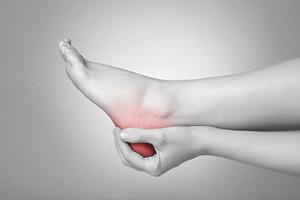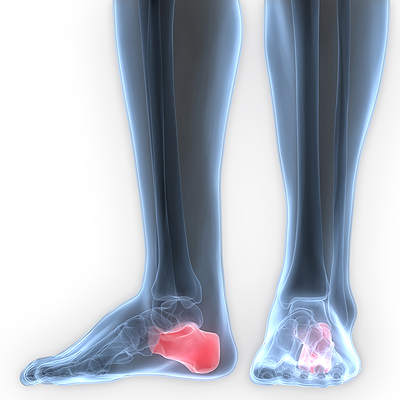
Wilmington (937) 382-2347
Fax
(513) 932-1606

Wilmington (937) 382-2347
Fax
(513) 932-1606
 A hairline crack in the bones of the feet is referred to as a stress fracture. This condition gradually occurs, and is often the result of frequently participating in running and jumping activities. Early symptoms can include pain while the activity is pursued. Common symptoms linked with this condition may diminish when prompt treatment is started. Many runners who have endured stress fractures often try to ignore the pain and discomfort that typically accompanies this condition, despite being aware of the rest that is needed for proper healing. Additional symptoms can include swelling, tenderness, and weakness in the foot. Effective treatment methods can include elevating the foot which may help to reduce swelling, and it is beneficial to wrap the foot in an elastic bandage that can offer adequate support. If you have a stress fracture that is impacting your foot, it is strongly suggested that you consult with a podiatrist who can recommend the best treatment options for you.
A hairline crack in the bones of the feet is referred to as a stress fracture. This condition gradually occurs, and is often the result of frequently participating in running and jumping activities. Early symptoms can include pain while the activity is pursued. Common symptoms linked with this condition may diminish when prompt treatment is started. Many runners who have endured stress fractures often try to ignore the pain and discomfort that typically accompanies this condition, despite being aware of the rest that is needed for proper healing. Additional symptoms can include swelling, tenderness, and weakness in the foot. Effective treatment methods can include elevating the foot which may help to reduce swelling, and it is beneficial to wrap the foot in an elastic bandage that can offer adequate support. If you have a stress fracture that is impacting your foot, it is strongly suggested that you consult with a podiatrist who can recommend the best treatment options for you.
Stress fractures occur when there is a tiny crack within a bone. To learn more, contact Dr. Gerald Perelman from Ohio. Our doctor can provide the care you need to keep you pain free and on your feet.
How Are They Caused?
Stress fractures are the result of repetitive force being placed on the bone. Since the lower leg and feet often carry most of the body’s weight, stress fractures are likely to occur in these areas. If you rush into a new exercise, you are more likely to develop a stress fracture since you are starting too much, too soon. Pain resulting from stress fractures may go unnoticed at first, however it may start to worsen over time.
Risk Factors
Stress fractures do not always heal properly, so it is important that you seek help from a podiatrist if you suspect you may have one. Ignoring your stress fracture may cause it to worsen, and you may develop chronic pain as well as additional fractures.
If you have any questions, please feel free to contact our office located in Wilmington, OH . We offer the newest diagnostic and treatment technologies for all your foot care needs.
 The band of tissue that connects the heel bone to the toes is known as the plantar fascia. If this tissue becomes inflamed, it’s likely the foot condition known as plantar fasciitis may develop. Plantar fasciitis can cause a great deal of heel pain for those affected. Early detection and prompt treatment can be helpful for a speedy recovery. There are a few signs to look out for if you believe you may have developed plantar fasciitis. If you are experiencing pain when you first step out of bed in the morning, when seated or standing for prolonged periods of time, or going up and down stairs, you may have plantar fasciitis. For a proper diagnosis and suggested plan of treatment, it’s suggested that you consult with a podiatrist.
The band of tissue that connects the heel bone to the toes is known as the plantar fascia. If this tissue becomes inflamed, it’s likely the foot condition known as plantar fasciitis may develop. Plantar fasciitis can cause a great deal of heel pain for those affected. Early detection and prompt treatment can be helpful for a speedy recovery. There are a few signs to look out for if you believe you may have developed plantar fasciitis. If you are experiencing pain when you first step out of bed in the morning, when seated or standing for prolonged periods of time, or going up and down stairs, you may have plantar fasciitis. For a proper diagnosis and suggested plan of treatment, it’s suggested that you consult with a podiatrist.
Plantar fasciitis can be very painful and inconvenient. If you are experiencing heel pain or symptoms of plantar fasciitis, contact Dr. Gerald Perelman from Ohio. Our doctor can provide the care you need to keep you pain-free and on your feet.
What Is Plantar Fasciitis?
Plantar fasciitis is the inflammation of the thick band of tissue that runs along the bottom of your foot, known as the plantar fascia, and causes mild to severe heel pain.
What Causes Plantar Fasciitis?
How Can It Be Treated?
While very treatable, plantar fasciitis is definitely not something that should be ignored. Especially in severe cases, speaking to your doctor right away is highly recommended to avoid complications and severe heel pain. Your podiatrist can work with you to provide the appropriate treatment options tailored to your condition.
If you have any questions please feel free to contact our office located in Wilmington, OH . We offer the newest diagnostic and treatment technologies for all your foot and ankle needs.
When someone experiences an Achilles tendon fracture, it is often accompanied by severe pain and discomfort. Some patients find it helpful to perform specific exercises following the initial treatment. This may help to strengthen the Achilles tendon and surrounding areas of the foot. Stretching the toes can be effective in lengthening the Achilles tendon. This is accomplished by pulling the big toe up and back while sitting in a chair. This tendon can also be stretched by standing on a step, and lowering the heel until it gently pulls in the back of the leg. If you have endured this type of injury, it is strongly suggested that you seek the advice of a podiatrist who can treat this ailment and guide you toward performing stretches that are correct for you.
Achilles tendon injuries need immediate attention to avoid future complications. If you have any concerns, contact Dr. Gerald Perelman of Ohio. Our doctor can provide the care you need to keep you pain-free and on your feet.
What Is the Achilles Tendon?
The Achilles tendon is a tendon that connects the lower leg muscles and calf to the heel of the foot. It is the strongest tendon in the human body and is essential for making movement possible. Because this tendon is such an integral part of the body, any injuries to it can create immense difficulties and should immediately be presented to a doctor.
What Are the Symptoms of an Achilles Tendon Injury?
There are various types of injuries that can affect the Achilles tendon. The two most common injuries are Achilles tendinitis and ruptures of the tendon.
Achilles Tendinitis Symptoms
Rupture Symptoms
Treatment and Prevention
Achilles tendon injuries are diagnosed by a thorough physical evaluation, which can include an MRI. Treatment involves rest, physical therapy, and in some cases, surgery. However, various preventative measures can be taken to avoid these injuries, such as:
If you have any questions please feel free to contact our office located in Wilmington, OH . We offer the newest diagnostic tools and technology to treat your foot and ankle needs.
 There are seven bones in the foot that are referred to as tarsal bones. The cuboid bone is included in this group, and it is located on the outside of the foot. An injury can cause the ligaments surrounding this bone to become inflamed, and this is known as cuboid syndrome. It can be a common injury among athletes, and can cause considerable pain and discomfort. It may happen as a result of frequently running for extended periods of time, or from medical conditions that can include flat feet. Recovery may often begin with eliminating the activity that caused the injury, followed by elevating the foot, which may help to reduce existing swelling. Some patients may find mild relief when the affected foot is taped, as this may offer additional stability as the healing process takes place. If you feel you may have cuboid’s syndrome, please consult with a podiatrist who can properly diagnose and treat this condition.
There are seven bones in the foot that are referred to as tarsal bones. The cuboid bone is included in this group, and it is located on the outside of the foot. An injury can cause the ligaments surrounding this bone to become inflamed, and this is known as cuboid syndrome. It can be a common injury among athletes, and can cause considerable pain and discomfort. It may happen as a result of frequently running for extended periods of time, or from medical conditions that can include flat feet. Recovery may often begin with eliminating the activity that caused the injury, followed by elevating the foot, which may help to reduce existing swelling. Some patients may find mild relief when the affected foot is taped, as this may offer additional stability as the healing process takes place. If you feel you may have cuboid’s syndrome, please consult with a podiatrist who can properly diagnose and treat this condition.
Cuboid syndrome, also known as cuboid subluxation, occurs when the joints and ligaments near the cuboid bone in the foot become torn. If you have cuboid syndrome, consult with Dr. Gerald Perelman from Ohio. Our doctor will assess your condition and provide you with quality foot and ankle treatment.
Cuboid syndrome is a common cause of lateral foot pain, which is pain on the outside of the foot. The condition may happen suddenly due to an ankle sprain, or it may develop slowly overtime from repetitive tension through the bone and surrounding structures.
Causes
The most common causes of cuboid syndrome include:
Symptoms
A common symptom of cuboid syndrome is pain along the outside of the foot which can be felt in the ankle and toes. This pain may create walking difficulties and may cause those with the condition to walk with a limp.
Diagnosis
Diagnosis of cuboid syndrome is often difficult, and it is often misdiagnosed. X-rays, MRIs and CT scans often fail to properly show the cuboid subluxation. Although there isn’t a specific test used to diagnose cuboid syndrome, your podiatrist will usually check if pain is felt while pressing firmly on the cuboid bone of your foot.
Treatment
Just as the range of causes varies widely, so do treatments. Some more common treatments are ice therapy, rest, exercise, taping, and orthotics.
If you have any questions, please feel free to contact our office located in Wilmington, OH . We offer the newest diagnostic and treatment technologies for all your foot care needs.